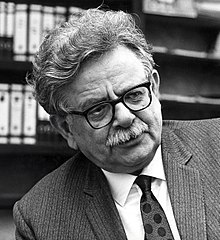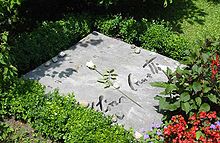卡内蒂 Elias Canetti (埃里亚斯·卡内蒂)
20200812
注解: 手指向下或右滑,翻到下一页,向上或左滑,到上一页。
卡内蒂

埃利亚斯·卡内蒂(德语:Elias Canetti,1905年7月25日-1994年8月14日)是保加利亚出生的塞法迪犹太人小说家、评论家、社会学家和剧作家,1981年诺贝尔文学奖得主,以德语写作。
卡内蒂的著名作品有自传三部曲:《得救之舌》、《耳中火炬》、《眼睛游戏》(Die Gerettete Zunge; Die Fackel im Ohr; Das Augenspiel)、现代主义小说《迷惘》(德语:Auto-da-Fé)和社会学著作《群众与权力》(Masse und Macht)。
生平
早期
埃利亚斯·卡内蒂生于多瑙河南岸的鲁斯丘克(Rustchuk),即是今天的鲁塞。他的家庭是1492年来自西班牙的瑟法底犹太人后裔,所以除了保加利亚语外,卡内蒂还会讲老式的西班牙语——拉迪诺语(一种已经遭废弃的方言)。其后卡内蒂一家迁至英国曼彻斯特,但父亲于1912年逝世,卡内蒂遂随母亲搬至维也纳,并开始学习德语。此后他母亲逼卡内蒂平日以德文沟通,日后他亦用了德文写作。
1924年卡内蒂入维也纳大学攻读化学,1929年获化学学士学位。不过期间他发觉自己更热衷于艺术、文学和哲学,故他一直没有当化学家,反而开始写作,完成了《年轻的罗马执政官》和一部诗歌戏剧。
30年代
到访过柏林和认识了一些艺术家后,卡内蒂开始创作一系列关于人类狂热行为的小说,如1935年的《迷惑》(Die Blendung),灵感来自1920年代暴民焚烧维也纳正义宫时的疯狂现象。此书颇受1929年诺贝尔文学奖得主保罗·托马斯·曼与英国哲学家兼小说家艾瑞斯·梅铎的赞赏。30年代,卡内蒂亦写了两部戏剧:《婚礼》(Die Hochzeit)和《浮华喜剧》(Der Eitelkeit)。不久,美国作家厄普顿·辛克莱开始翻译其著作。
1938年,纳粹侵占奥地利,身为犹太人的卡内蒂逃到巴黎,次年定居伦敦。余生大多在英国渡过,并主要用英语发表作品,因此有些作品先有英文版本,然后再由他译成德文出版。而其小说则被纳粹封查,至60年代才重新得到重视。
战后
在英国,卡内蒂停止了文学创作,着手写论文集《群众与权力》。
晚年

卡内蒂居于苏黎世。1981年因为“作品具有宽广的视野、丰富的思想和艺术力量”而获得诺贝尔奖。
1994年8月14日,卡内蒂逝世。
文学奖
- 格奥尔·毕希纳奖(1972年)
- 约翰·彼得·赫贝尔奖(1980年)
- 卡夫卡奖(1981年)
- 诺贝尔文学奖(1981年)
- 奈利·萨克斯奖(1995年)
著作
卡内蒂发表了19部著作,其中最有影响的是《群众与权力》
长篇小说
- 《迷惘(小说)》(Die Blendung,1935年)
剧本
卡内蒂的剧本都没有主角或连贯的情节,却只表现某些场面。其中的事件都是卡夫卡式的。
- 《婚礼 (戏剧)》(Die Hochzeit,1932年):叙述腐朽社会的没落与崩溃
- 《浮华喜剧》(Der Eitelkeit,1934年)
- 《确定死期的人们》(Die Befristeten,1956年):叙述极权主义社会中人们的不安全感
论文集
- 《群众与权力》(Masse und Macht,1960年):分析当年法西斯取得权力和群众支持的原因(群众受愚弄)
- 《耳闻集》(Der Ohrenzeuge-Funfzig Charaktere,1974年):评价五十位作家
自传
其他
- 《卡夫卡的另一场审判》(Der andere Prozess,1969年)
- 《Hitler nach Speer》
- 《人的省份》(1942-1972年)
- 《良心话》(1975年)
- 《目语》(1985年)
- 《钟表的神秘心脏:杂记》(1987年)
- 《Die Fliegenpein》
- 《Nachträge aus Hampstead》
- 《Party im Blitz; Die englischen Jahre》(2003年)
- 《Aufzeichnungen für Marie-Louise》(2005年)
作品在台湾的出版
- 陈卫平、黄汉青/译,《群众与权力》,板桥市:骆驼,1987年。
- 梁景峰/译,蔡源煌等人/主编,《卡内提》,台北市:光复,1993年。
- 宋碧云/译,《被拯救的舌头》,台北市:远景。
- 诺贝尔文学奖全集编译委员会/编,《卡内提》,台北市:九华出版。
- 李舒章/译,《迷惘》,台北市:远景。
- 林维杰/译,《聆听马拉喀什》,台北市:马可孛罗,2004年。
- 林维杰/译,《得救的舌头:一个青年人的故事1905-1921》,台北市:台湾商务,2004年。
- 杨梦茹/译,《耳中的火炬:十年的成长历程1921-1931》,台北市:台湾商务,2004年。
- 黄铭惇/译,《目光的游戏:生命史1931-1937》,台北市:台湾商务,2004年。
- 郑树森/译,《耳闻证人》,台北市:允晨文化,2012年。
参考资料
外部链接
Canetti moved to England in 1938 after the Anschluss to escape Nazi persecution. He became a British citizen in 1952. He is known as a modernist novelist, playwright, memoirist, and non-fiction writer.[2] He won the Nobel Prize in Literature in 1981, "for writings marked by a broad outlook, a wealth of ideas and artistic power".[3] He is noted for his non-fiction book Crowds and Power, among other works.
Life and work
Early life
Born in 1905 to businessman Jacques Canetti and Mathilde née Arditti in Ruse, a city on the Danube in Bulgaria, Canetti was the eldest of three sons.[4] His ancestors were Sephardi Jews.[5] His paternal ancestors settled in Ruse from Ottoman Adrianople.[4] The original family name was Cañete, named after Cañete, Cuenca, a village in Spain.
In Ruse, Canetti's father and grandfather were successful merchants who operated out of a commercial building, which they had built in 1898.[6] Canetti's mother descended from the Arditti family, one of the oldest Sephardi families in Bulgaria, who were among the founders of the Ruse Jewish colony in the late 18th century. The Ardittis can be traced to the 14th century, when they were court physicians and astronomers to the Aragonese royal court of Alfonso IV and Pedro IV. Before settling in Ruse, they had migrated into Italy and lived in Livorno in the 17th century.[7]
Elias Canetti's native house in Ruse, Bulgaria
Canetti spent his childhood years, from 1905 to 1911, in Ruse until the family moved to Manchester, England, where Canetti's father joined a business established by his wife's brothers. In 1912, his father died suddenly, and his mother moved with their children first to Lausanne, then Vienna in the same year. They lived in Vienna from the time Canetti was aged seven onwards. His mother insisted that he speak German, and taught it to him. By this time Canetti already spoke Ladino (his native language), Bulgarian, English, and some French; the latter two he studied in the one year they were in Britain. Subsequently, the family moved first (from 1916 to 1921) to Zürich and then (until 1924) to Frankfurt, where Canetti graduated from high school.
Canetti went back to Vienna in 1924 in order to study chemistry. However, his primary interests during his years in Vienna became philosophy and literature. Introduced into the literary circles of First-Republic-Vienna, he started writing. Politically leaning towards the left, he was present at the July Revolt of 1927 – he came near to the action accidentally, was most impressed by the burning of books (recalled frequently in his writings), and left the place quickly with his bicycle.[8] He gained a degree in chemistry from the University of Vienna in 1929, but never worked as a chemist.
He published two works in Vienna before escaping to Great Britain. He reflected the experiences of Nazi Germany and political chaos in his works, especially exploring mob action and group thinking in his novel Die Blendung (Auto-da-Fé, 1935) and non-fiction Crowds and Power (1960). He wrote several volumes of memoirs, contemplating the influence of his multi-lingual background and childhood.
Canetti's tomb-stone in Zürich, Switzerland
Personal life
Canetti Peak, Antarctica, named after Elias Canetti
In 1934 in Vienna he married Veza (Venetiana) Taubner-Calderon (1897–1963), who acted as his muse and devoted literary assistant. Canetti remained open to relationships with other women. He had a short affair with Anna Mahler. In 1938, after the Anschluss with Germany, the Canettis moved to London. He became closely involved with the painter Marie-Louise von Motesiczky, who was to remain a close companion for many years. His name has also been linked with the author Iris Murdoch (see John Bayley's Iris, A Memoir of Iris Murdoch, which has several references to an author, referred to as "the Dichter", who was a Nobel Laureate and whose works included Die Blendung [English title Auto-da-Fé]).
After Veza died in 1963, Canetti married Hera Buschor (1933–1988), with whom he had a daughter, Johanna, in 1972. Canetti's brother Jacques Canetti settled in Paris, where he championed a revival of French chanson.[9] Despite being a German-language writer, Canetti settled in Britain until the 1970s, receiving British citizenship in 1952. For his last 20 years, Canetti lived mostly in Zürich.
Career
A writer in German, Canetti won the Nobel Prize in Literature in 1981, "for writings marked by a broad outlook, a wealth of ideas and artistic power". He is known chiefly for his celebrated trilogy of autobiographical memoirs of his childhood and of pre-Anschluss Vienna: Die Gerettete Zunge (The Tongue Set Free); Die Fackel im Ohr (The Torch in My Ear), and Das Augenspiel (The Play of the Eyes); for his modernist novel Auto-da-Fé (Die Blendung); and for Crowds and Power, a psychological study of crowd behaviour as it manifests itself in human activities ranging from mob violence to religious congregations.
In the 1970s, Canetti began to travel more frequently to Zurich, where he settled and lived for his last 20 years. He died in Zürich in 1994.[10]
Honours and awards
Prix International (France, 1949)
Grand Austrian State Prize for Literature (1967)
Literature Award of the Bavarian Academy of the Fine Arts (1969)
Austrian Decoration for Science and Art (1972)[11]
Georg Büchner Prize (German Academy for Language and Literature, 1972)
German recording prize, for reading "Ohrenzeuge" (Deutscher Schallplattenpreis) (1975)
Nelly Sachs Prize (1975)
Gottfried-Keller-Preis (1977)
Pour le Mérite (1979)
Johann-Peter-Hebel-Preis (Baden-Württemberg, 1980)
Nobel Prize in Literature (1981)
Franz Kafka Prize[12] (1981)
Grand Merit Cross of the Order of Merit of the Federal Republic of Germany (1983)
In 1975, Canetti was awarded an honorary doctorate from the University of Manchester and another from the Ludwig Maximilian University of Munich, in 1976.
Canetti Peak on Livingston Island in the South Shetland Islands, Antarctica, is named after him.
Works
Komödie der Eitelkeit 1934 (The Comedy of Vanity)
Die Blendung 1935 (Auto-da-Fé, novel, tr.1946)
Die Befristeten 1956 (1956 premiere of the play in Oxford) (Their Days are Numbered)
Masse und Macht 1960 (Crowds and Power, study, tr. 1962, published in Hamburg)
Aufzeichnungen 1942 – 1948 (1965) (Sketches)
Die Stimmen von Marrakesch 1968 published by Hanser in Munich (The Voices of Marrakesh, travelogue, tr. 1978)
Der andere Prozess 1969 Kafkas Briefe an Felice (Kafka's Other Trial, tr. 1974).
Hitler nach Speer (Essay)
Die Provinz des Menschen Aufzeichnungen 1942 – 1972 (The Human Province, tr. 1978)
Der Ohrenzeuge. Fünfzig Charaktere 1974 ("Ear Witness: Fifty Characters", tr. 1979).
Das Gewissen der Worte 1975. Essays (The Conscience of Words)
Die Gerettete Zunge 1977 (The Tongue Set Free, memoir, tr. 1979 by Joachim Neugroschel)
Die Fackel im Ohr 1980 Lebensgeschichte 1921 – 1931 (The Torch in My Ear, memoir, tr. 1982)
Das Augenspiel 1985 Lebensgeschichte 1931 – 1937 (The Play of the Eyes, memoir, tr. 1990)
Das Geheimherz der Uhr: Aufzeichnungen 1987 (The Secret Heart of the Clock, tr. 1989)
Die Fliegenpein (The Agony of Flies, 1992)
Nachträge aus Hampstead (Notes from Hampstead, 1994)
The Voices of Marrakesh (published posthumously, Arion Press, 2001, with photographs by Karl Bissinger and etchings by William T. Wiley )
Party im Blitz; Die englischen Jahre 2003 (Party in the Blitz, memoir, published posthumously, tr. 2005)
Aufzeichnungen für Marie-Louise (written 1942, compiled and published posthumously, 2005)
See also
Crowd psychology
List of Nobel laureates by country
Marie-Louise von Motesiczky
Ruth von Mayenburg
References
"Canetti". Random House Webster's Unabridged Dictionary.
Lorenz, Dagmar C.G. (2009). "Introduction". A Companion to the Works of Elias Canetti. Twayne Publishers. pp. 350. ISBN 978-080-578-276-9.
nobelprize.org. "The Nobel Prize in Literature 1981". Retrieved 8 April 2014.
Lorenz, Dagmar C. G. (17 April 2004). "Elias Canetti". Literary Encyclopedia. The Literary Dictionary Company Limited. ISSN 1747-678X. Retrieved 13 October 2009.
"Heroes – Trailblazers of the Jewish People". Beit Hatfutsot.
"The Canetti House – a forum for alternative culture". Internationale Elias Canetti Gesellschaft. Archived from the original on 24 March 2010. Retrieved 2009-10-13.
Angelova, Penka (2006). "Die Geburtsstadt von Elias Canetti" (PDF). Elias Canetti: Der Ohrenzeuge des Jahrhunderts (in German). Internationale Elias-Canetti-Gesellschaft Rousse. Archived from the original (PDF) on 10 April 2018. Retrieved 29 October 2017.
Stieg, Gerard, Fruits de Feu - l'incendie du Palais du Justice de Vienne en 1927 et ses consequences dans la Littérature Autrichienne. Université de Rouen (ISBN 9782877750080), 1989.
Patrick Labesse (10 June 1997). "Jacques Canetti, Le découvreur de Brassens et de Brel". Le Monde. Retrieved 22 January 2015.
Encyclopædia Britannica profile
"Reply to a parliamentary question" (PDF) (in German). p. 348. Retrieved 19 October 2012.
"Hanser Verlag author page". Retrieved 12 November 2013.
Bibliography
Parry, I. "Attitudes to Power", in I. Parry, Speak Silence (1988), p. 253-
Manuel Vázquez Montalbán and Willi Glasauer (1988). Scenes from World Literature and Portraits of Greatest Authors. Barcelona: Círculo de Lectores.
Gentis, Roger La folie Canetti, Paris: Maurice Nadeau, 1993
Donahue, William Collins The End of Modernism: Elias Canetti’s Auto-da-Fé (University of North Carolina Press, 2001).
Brill, Lesley "Terrorism, "Crowds and Power", and the Dogs of War", Anthropological Quarterly 76(1), Winter 2003: 87–94.[1]
Morgan, Peter (2005) "Georges Kien and the 'Diagnosis of Delusion' in Elias Canetti's Die Blendung", Twentieth-Century Literary Criticism Volume 157. United States: Gale.
Donahue, William Collins and Julian Preece (eds), The Worlds of Elias Canetti: Centenary Essays (Cambridge Scholars Publishing, 2007).
Lorenz, Dagmar C.G. (2009). "Introduction": A Companion to the Works of Elias Canetti.
Brighenti, Andrea Mubi "Elias Canetti and the Counter-Image of Resistance", Thesis Eleven, August 2011 vol. 106 no. 1 73-87.[2]
Antonello Lombardi, La scuola dell’ascolto: Oralità, suono e musica nell’opera di Elias Canetti, Ut Orpheus Edizioni, Bologna 2011, ISBN 978-88-8109-474-5
Antonello Lombardi, "Gli animali mancanti: La fauna nell'opera di Elias Canetti", in In forma di parole, Animali, volume secondo, IV 2012, Bologna 2013.
Antonello Lombardi, Le memorie di Georges Kien, Portatori d'Acqua, Pesaro 2015, ISBN 978-88-987790-3-1
Antonello Lombardi, "Elias Canetti e la scuola dell'ascolto", in Nuova informazione bibliografica (il Mulino)] 2/2016, aprile-giugno
External links
Wikimedia Commons has media related to Elias Canetti.
Wikiquote has quotations related to: Elias Canetti
Encyclopædia Britannica profile
Preface to Donahue, The End of Modernism
Works by Elias Canetti at Open Library Edit this at Wikidata
Works by or about Elias Canetti in libraries (WorldCat catalog)
Elias Canetti at perlentaucher.de – das Kulturmagazin (in German)
Elias Canetti, Nobel Luminaries - Jewish Nobel Prize Winners, on the Beit Hatfutsot-The Museum of the Jewish People Website.
Works by or about Elias Canetti at Internet Archive

